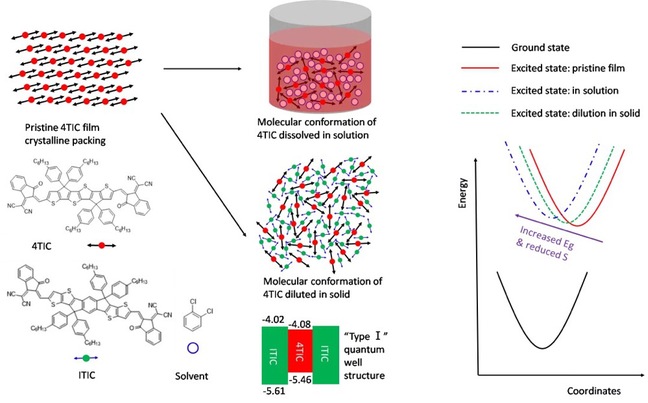Have you ever thought of a day like this?
While the sunlight is streaming through huge French windows, the temperature inside the room is not rising at all; however the energy is stored and applied elsewhere quietly.
This is not a dream; it is a research being conducted by scientists.
Organic solar cells (or organic photovoltaic devices), applied with organic conjugated molecules (or polymers) as the photosensitive layer and prepared by solution processing, are characterized by low cost, light weight, flexibility, being colorful and translucent, so they are used for a wider range of scenarios, and can even be made into building glass.
However, compared with silicon solar cells, organic solar cells still have low photoelectric conversion efficiency, which is one of the major obstacles to their industrialization. In recent years, it has been discovered that the co-blending of multiple organic dye molecules (i.e., multiple-blending strategy) can effectively improve the efficiency of photovoltaic devices; however, the principle still remains unknown, which also leads to the lack of material screening guidelines for multiple-component blending devices and being a hindrance for making high-performance devices.

Dr. Zuo Lijian, a young PI at the Institute of Future Science, ZJU-Hangzhou Global Scientific and Technological Innovation Center, has made an important progress in this field by revealing for the first time the principle of “dilution effect” (organic dye molecular blending), which provides a basis for the screening of multiple-component blending device materials from the perspective of physical principles. The result entitled “Dilution effect for highly efficient multiple-component organic solar cells” was published in Nanotechnology, a series of Nature.

Exercising “catfish effect” to activate the “still water” of organic photovoltaic devices
As known to all, solar energy is currently an ideal clean energy. Solar cells at present, mainly of monocrystalline silicon devices, have the advantages of high conversion efficiency, long service life and others; however, they also have shortcomings, e.g. fragile texture, monotone color, high preparation costs and long energy return cycle. Therefore, organic photovoltaic cells have become a new R & D tendency.
In comparison, organic photovoltaic cells show obvious advantages, e.g. light weight, simple fabrication, and broad application prospects as they can be used to prepare large area flexible devices with low-cost printing process. Therefore, it is the focus of current research to improve the efficiency of photovoltaic.
Based on the previous experiments of other scholars, Dr. Zuo Lijian’s team revealed the principle of “dilution effect” for the first time. They found that when organic light-emitting dyes are dispersed in a wide band gap dye molecule, the band gap of the molecule will turn wider, the electron-vibration coupling be reduced, the non-radiative compound energy loss of the system reduced, and the photoelectric conversion efficiency improved. It is like putting catfish to a school of carp, the efficiency of fish movement will be increased. The study discovered further that the charge in the multiple-component blending system can be transferred “freely” at the interface of molecular heterojunction, which provides a theoretical basis for adding receptors to improve conversion efficiency.

Based on this “dilution effect” principle, the research team proposed design guidelines for material selection of multiple-component organic photovoltaic devices, including compatibility, energy level structure, band gap and other requirements, and achieved success in the preparation of organic photovoltaic devices with a performance of up to 18.3%, which was a strong impetus to the industrialization of organic photovoltaics.
Pursuing an “Industrial Dream” at the Center
How to empower daily life with sci-technology innovation? Dr. Zuo Lijian, after getting his doctorate in Zhejiang University, has been making explorations in the research of materials and device performance structure-effect relationship and device physics. He used to work on the science of materials at the University of Washington. He has made breakthroughs in device performance through innovative design of materials and device structures, published 80-odd papers in Science Advances, JACS, Nature Communications and other top journals, and has been granted one patent.

In his opinion, serving industrial progress with science and technology and disseminating scientific principles in a better way are as important as sci-tech innovations, so it is the reason that he chose to work for the Center. He hopes to realize his dream of “serving China with science and technology” on this platform.
“I am currently engaged in research on perovskite at the Institute of Future Science of the Center. If the material used in organic solar cells is “plastic semiconductor”, which can be obtained through solution processing, then the material used in perovskite cells is “salt”, which is like a transition zone between silicon materials and solution-processable polymers, integrating the advantages of both, with important research value and broad application prospects!
Zuo Lijian said that his research project is an interdisciplinary one of materials, chemistry, physics, optics and other areas, and the Institute of Future Science at the Center is dedicated to exploring these frontier technologies that may have a significant impact on industrial development in the future. “Research can not be carried out in closed doors; researchers should see the industry themselves, understand its real needs and conduct research with application value!”
Together with his team members, he hopes to make good use of this high-energy multidisciplinary innovation platform to focus on such forward-looking research issues as the stability of perovskite solar cells and to provide research support for large-scale application and mass production of academic fruits.












